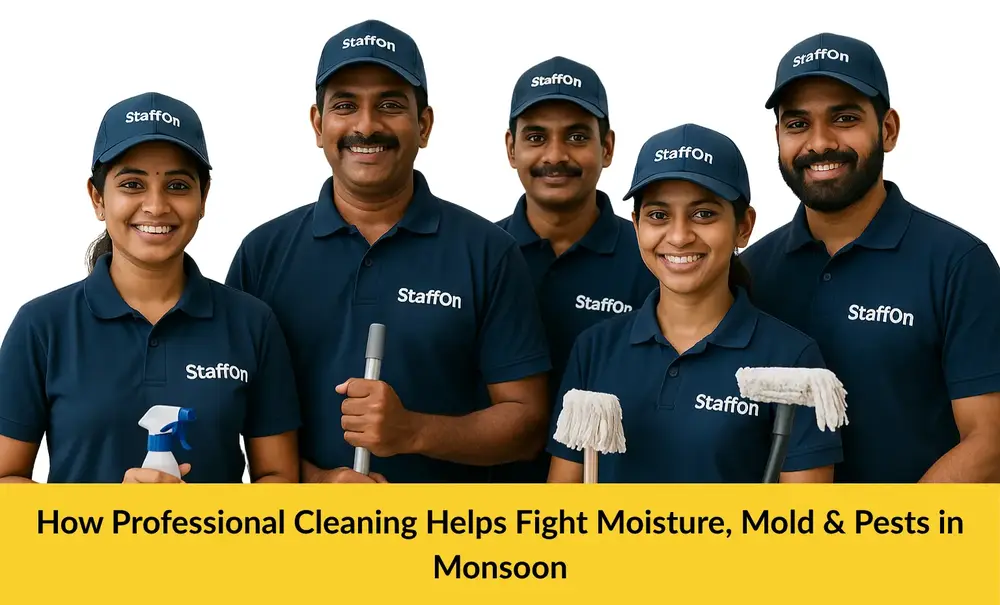Top 5 Reasons to Choose Staffon for House Cleaning Services in Kozhikode
Top 5 Reasons to Choose Staffon for House Cleaning Services in Kozhikode A Cleaner Home Starts With the Right Partner Choosing a reliable house cleaning service in Kozhikode can significantly impact the comfort, hygiene, and overall wellbeing of your household. With the rising demand for professional cleaning due to hectic lifestyles and health-conscious living, finding a dependable provider becomes essential. Here’s why discerning residents of Kozhikode are increasingly turning to one name — Staffon. 1. Precision-Driven Deep Cleaning Standards In a climate like Kozhikode’s, where humidity levels often result in dust, mold, and allergens building up fast, general surface cleaning doesn’t suffice. What truly matters is a deep, meticulous cleanse that goes beyond visible dirt. Staffon employs trained professionals who are adept at handling all types of residential surfaces — from tile and granite to glass and wood. Their use of industrial-grade, eco-friendly cleaning agents ensures that your living spaces are not only spotless but also sanitized. Whether it’s kitchen grease, bathroom mildew, or bedroom allergens, every zone gets a tailored approach. By choosing Staffon’s house cleaning service, you eliminate the risk of missed corners and superficial results. Their checklists are exhaustive, ensuring every inch of your home — including vents, blinds, baseboards, and under-furniture zones — is cleaned to perfection. 2. Custom Packages Designed Around Your Lifestyle Not all homes are the same. A household with young children has different cleaning requirements from a bachelor’s flat or an elderly couple’s residence. Staffon stands out by offering customizable cleaning plans, allowing clients to schedule weekly, bi-weekly, or one-time deep cleans. Clients can choose from specialized add-ons such as upholstery sanitizing, balcony scrubbing, or mattress shampooing. This adaptability makes Staffon’s house cleaning service ideal for busy professionals, families, or even homeowners preparing for festive seasons. In Kozhikode’s vibrant social culture, frequent visitors, events, and celebrations can increase wear and tear in homes. Staffon’s plans are designed to offer flexible relief without interrupting your schedule. 3. Technologically Advanced Tools for Superior Results Traditional mop-and-bucket methods are increasingly ineffective in today’s hygiene-conscious world. Staffon leverages high-suction vacuum systems, steam cleaners, microfiber mops, and HEPA-filter dusters to achieve long-lasting cleanliness. These advanced tools penetrate deep into rugs, curtains, and upholstery — eliminating mites, pollen, and other airborne pollutants common in coastal cities like Kozhikode. The result? Your home looks not just clean, but feels fresh and allergen-free. Staffon’s cleaning professionals receive regular technical training to operate this modern equipment efficiently, ensuring both safety and performance. Their house cleaning service doesn’t just clean; it rejuvenates your space using industry-leading technology. 4. Transparent Pricing with No Hidden Surprises Budget-conscious homeowners often hesitate to hire professional services, fearing vague quotes and surprise charges. Staffon eliminates these concerns with a crystal-clear pricing model. Every estimate is provided upfront, based on square footage, selected services, and frequency. There are no hidden fees — no last-minute “deep cleaning” add-ons or equipment surcharges. The process begins with a thorough inspection (either in person or via video call) to understand the home’s needs. Once agreed, the pricing is locked in. This transparency has helped Staffon earn trust across Kozhikode. Their fair, consistent rates reflect their commitment to honest business and customer-first ethics — a quality often missing in generic house cleaning service providers. 5. Trusted Professionals with Background Verification Letting someone into your home demands more than just skill — it requires trust. Staffon conducts rigorous background checks on every cleaner before hiring. Their professionals are not only trained but also verified, uniformed, and insured. In Kozhikode, where homes often include valuable antiques, electronics, and sensitive areas like pooja rooms, clients value discretion and reliability. Staffon enforces strict confidentiality policies and conducts frequent internal reviews. Moreover, customer support is always within reach. Whether it’s a rescheduling request, feedback, or a complaint, Staffon maintains an open line of communication with clients, ensuring that the trust once built is never compromised. Why Kozhikode Homes Deserve Better Cleaning Standards Kozhikode’s unique cultural and climatic setting demands a specialized approach to domestic hygiene. Monsoons bring humidity, summer brings dust, and celebrations bring foot traffic. Homes here are dynamic — and maintaining them requires more than a broom and disinfectant. Professional house cleaning services bridge the gap between surface tidiness and deep wellness. They free up your time, reduce health risks, and extend the lifespan of your interiors. Staffon’s tailored cleaning methodologies are designed with Kozhikode homes in mind — culturally aware, environmentally safe, and consistently reliable. Additional Benefits That Set Staffon Apart Eco-Conscious Cleaning Solutions Staffon uses plant-based, biodegradable products that are safe for children, pets, and the environment. Their cleaning protocols minimize water wastage and chemical residue, aligning with Kozhikode’s sustainability goals. Responsive Customer Support From WhatsApp booking confirmations to post-cleaning surveys, Staffon keeps its communication seamless. Support teams are available throughout the week to handle queries, complaints, or rescheduling needs. Service Guarantee Unsatisfied with any part of the service? Staffon offers a “clean again for free” promise. This level of confidence in service quality is rare and demonstrates their commitment to customer satisfaction. Local Expertise Being rooted in Kozhikode, Staffon understands local weather patterns, architectural quirks, and community expectations better than any external provider. Their cleaners are locals too — which brings not just cultural sensitivity, but also local accountability. Final Thoughts For homeowners in Kozhikode seeking more than just cleanliness — seeking peace of mind, consistent quality, and real hygiene — Staffon stands as the obvious choice. Their blend of professionalism, technology, and personalized care has set a new standard for house cleaning services in the region. When you choose Staffon, you’re not just hiring cleaners. You’re investing in a healthier, brighter, and more dignified home life. Visit StaffonGlobal.com to schedule your consultation and experience Kozhikode’s most trusted house cleaning service firsthand. For more details, visit WHO’s official website for trusted health care information.










